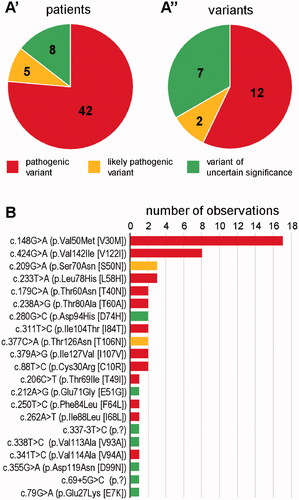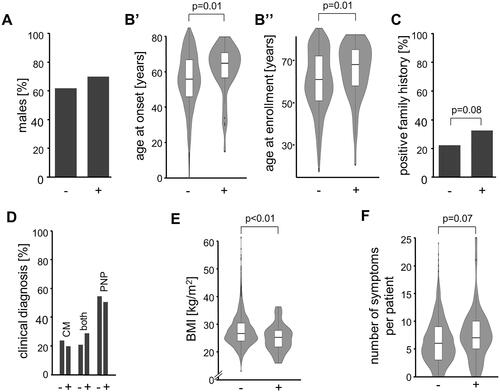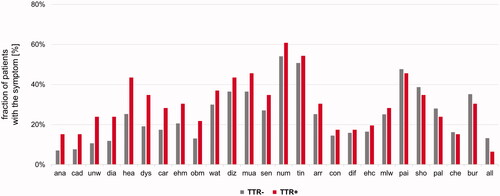Figures & data
Table 1. Current symptoms for polyneuropathy and cardiomyopathy of undetermined aetiology.
Figure 1. TTR variants as identified by the present study. (A) Fraction of the three relevant classes amongst patients (A’) and variants (A”). Absolute numbers are provided within the charts. (B) Number of observations of individual variants. Colour shade-coding as in (A).

Table 2. TTR heterozygous variants in patients with PNP and/or CM.
Figure 2. Comparison of TTR-positive and TTR-negative study participants (TTR-status on the x-axis in all charts). (A) Gender. (B) Ages at disease onset and enrolment. (C) Family history. (D) Manifestation as cardiomyopathy (CM), polyneuropathy (PNP), or both. (E) Body Mass Index (BMI). (F) Number of symptoms.

Figure 3. Frequency of individual symptoms with TTR-negative (TTR−) depicted in grey and TTR-positive (TTR+) in red colour. Symptoms that show discrepancies between TTR-negative and TTR-positive study participants are depicted on the left. Symptoms in alphabetical order: All: Allodynia; ana: Anaemia; arr: Arrhythmia; bur: “burning feet”; car: History of carpal tunnel syndrome; che: Chest pain; cad: Bouts of constipation that alternate with diarrhoea; con: Constipation; dia: Diarrhoea; dif: Difficulty urinating or holding urine; diz: Dizziness or fainting upon standing; dys: Dyshidrosis; ehc: Enlargement of heart cavities; ehm: Enlargement of heart muscle; hea: Abnormal (fluttering) heartbeat; mlw: Muscle weakness in the legs; mua: Muscle atrophy in the legs; num: Numbness; obm: Inability to obtain or maintain an erection; pai: Pain; pal: Palpitation; sen: Reduced ability to sense temperature; sho: Shortness of breath; tin: Tingling; unw: Unintentional weight loss; wat: Water accumulation in the ankles and lower limbs.

Supplemental Material
Download ()Data availability statement
The data that support the findings of this study are available upon reasonable request from the corresponding author, J.H. (email: [email protected]). The data are not publicly available due to containing information that could compromise the privacy of research participants.
